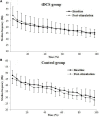Halo Sport Transcranial Direct Current Stimulation Improved Muscular Endurance Performance and Neuromuscular Efficiency During an Isometric Submaximal Fatiguing Elbow Flexion Task
- PMID: 35250511
- PMCID: PMC8891483
- DOI: 10.3389/fnhum.2022.758891
Halo Sport Transcranial Direct Current Stimulation Improved Muscular Endurance Performance and Neuromuscular Efficiency During an Isometric Submaximal Fatiguing Elbow Flexion Task
Abstract
The present study examined the effects of transcranial direct current stimulation (tDCS) using Halo Sport on the time to exhaustion (TTE) in relation with muscle activities and corticomuscular coupling of agonist and antagonist muscles during a sustained isometric fatiguing contraction performed with the elbow flexors. Twenty healthy male college students were randomly assigned to tDCS group and control group. The two group participants performed two experimental sessions which consisted of pre-fatigue isometric maximal voluntary contraction (MVC), sustained submaximal voluntary contractions (30% maximal torque) performed to exhaustion, and post-fatigue MVC with the right elbow flexor muscles. Sham stimulation (90 s) and tDCS (20 min) were applied for control and tDCS group participants 20 min prior to the second session test, respectively. MVC strength in pre- and post-fatigue test, TTE, electroencephalogram (EEG), and electromyography (EMG) of biceps brachii (BB) and triceps brachii (TB) were recorded during the tests. It was found that tDCS using the Halo Sport device significantly increased TTE and thus improved muscular endurance performance. The improvement may be partly related to the improvement of neuromuscular efficiency as reflected by decrease of antagonistic muscle coactivation activities, which may be related to cortical originated central processing mechanism of neuromuscular activities.
Keywords: EEG; EMG; endurance performance; halo sport; tDCS.
Copyright © 2022 Wang, Wang, Yang, Shao, Niu, Yang and Zheng.
Conflict of interest statement
The authors declare that the research was conducted in the absence of any commercial or financial relationships that could be construed as a potential conflict of interest.
Figures








Similar articles
-
Anodal transcranial direct current stimulation enhances time to task failure of a submaximal contraction of elbow flexors without changing corticospinal excitability.Neuroscience. 2016 May 13;322:94-103. doi: 10.1016/j.neuroscience.2016.02.025. Epub 2016 Feb 15. Neuroscience. 2016. PMID: 26892298
-
Anodal transcranial direct current stimulation alters elbow flexor muscle recruitment strategies.Brain Stimul. 2014 May-Jun;7(3):443-50. doi: 10.1016/j.brs.2014.01.057. Epub 2014 Jan 29. Brain Stimul. 2014. PMID: 24582369
-
Muscle Fatigue Enhance Beta Band EMG-EMG Coupling of Antagonistic Muscles in Patients With Post-stroke Spasticity.Front Bioeng Biotechnol. 2020 Aug 18;8:1007. doi: 10.3389/fbioe.2020.01007. eCollection 2020. Front Bioeng Biotechnol. 2020. PMID: 32974323 Free PMC article.
-
Acute effects of single dose transcranial direct current stimulation on muscle strength: A systematic review and meta-analysis.PLoS One. 2018 Dec 26;13(12):e0209513. doi: 10.1371/journal.pone.0209513. eCollection 2018. PLoS One. 2018. PMID: 30586389 Free PMC article.
-
The Effect of Transcranial Direct Current Stimulation on Lower-Limb Endurance Performance: A Systematic Review.Bioengineering (Basel). 2024 Oct 30;11(11):1088. doi: 10.3390/bioengineering11111088. Bioengineering (Basel). 2024. PMID: 39593748 Free PMC article. Review.
Cited by
-
Effects of high-definition transcranial direct current stimulation on the cortical-muscular functional coupling and muscular activities of ankle dorsi-plantarflexion under running-induced fatigue.Front Physiol. 2023 Sep 29;14:1263309. doi: 10.3389/fphys.2023.1263309. eCollection 2023. Front Physiol. 2023. PMID: 37841316 Free PMC article.
-
Acute anodal transcranial direct current stimulation improves the performance of professional rowers.Front Sports Act Living. 2024 Apr 18;6:1310856. doi: 10.3389/fspor.2024.1310856. eCollection 2024. Front Sports Act Living. 2024. PMID: 38699626 Free PMC article.
-
Effect of Eight-Week Transcranial Direct-Current Stimulation Combined with Lat Pull-Down Resistance Training on Improving Pull-Up Performance for Male College Students.Life (Basel). 2025 Jan 20;15(1):128. doi: 10.3390/life15010128. Life (Basel). 2025. PMID: 39860068 Free PMC article.
-
Transcranial electrical stimulation (TES) in human motor Optimization: Mechanisms, safety, and emerging applications.Biochem Biophys Rep. 2025 Jun 2;43:102055. doi: 10.1016/j.bbrep.2025.102055. eCollection 2025 Sep. Biochem Biophys Rep. 2025. PMID: 40519699 Free PMC article. Review.
-
Effects of anodic transcranial direct current stimulation combined with physical training on the performance of elite swimmers.Front Physiol. 2024 Apr 11;15:1383491. doi: 10.3389/fphys.2024.1383491. eCollection 2024. Front Physiol. 2024. PMID: 38665598 Free PMC article.
References
-
- Bastani A., Jaberzadeh S. (2012). Does anodal transcranial direct current stimulation enhance excitability of the motor cortex and motor function in healthy individuals and subjects with stroke: a systematic review and meta-analysis. Clin. Neurophysiol. 123 644–657. 10.1016/j.clinph.2011.08.029 - DOI - PubMed
LinkOut - more resources
Full Text Sources

